
Illustration of trees, foliage, and seed cones [Matt Strieby, 2025].

Forest of Abies concolor and Populus tremuloides on the slopes of Mt. Nebo, Utah [C.J. Earle, 2017.09.22].

Open, mixed forest of Abies concolor ssp. concolor, Pinus jeffreyi, and P. lambertiana on Mt. San Jacinto, California [C.J. Earle, 2019.05.24].

Abies concolor in habitat with Pinus ponderosa and P. longaeva at Bryce Canyon National Park, Utah [C.J. Earle, 2013.12.05].

A tree in the pure, N-facing stand S of Wellman Cienega on Mt. San Jacinto, CA. 150.0 cm dbh and about 30 m tall [C.J. Earle, 2004.04.10].
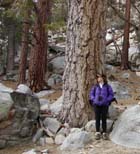
A large tree at 8400 feet elevation in Long Valley on Mt. San Jacinto, CA [C.J. Earle, 2002.03.06].
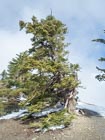
Tree ca. 7 m tall on Mt. San Antonio, California, grows near the alpine timberline and shows evidence of krummholz growth form [C.J. Earle, 2019.05.24].

Sapling 1.4 m tall, Siskiyou Mtn., CA-OR border [C.J. Earle, 2009.07.12].
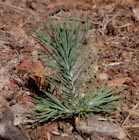
Seedling ca. 5 cm tall, established naturally after fire, mountains near Quincy, CA [C.J. Earle, 2002.03.06].

Foliage with ripe pollen cones; specimen of subsp. concolor on Mt. San Antonio, California. Note stomata on upper surface of leaf [C.J. Earle, 2019.05.24].

Foliage on this tree near Navajo Lake, Utah shows the abundant stomata and intense glaucousness that gave it the name "white fir" [C.J. Earle, 2017.09.20].
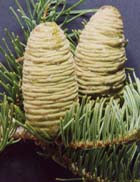
Cones collected 2002.08.03 from a tree near Spooner Lake, Nevada. (Lake Tahoe Basin) 2,070 m [Jeff Bisbee].

Bark on an 80 cm diameter tree in Nevada [C.J. Earle, 2001.09.27].
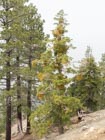
(Above and below) Trees in the Transverse Ranges of California seem to frequently have severe mistletoe infestations [C.J. Earle, 2019.05.23].
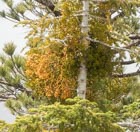

Conservation Status

Abies concolor
(Gordon & Glend.) Lindl. ex Hildebr. (1861)
Common names
White fir, balsam fir, silver fir, white balsam (Peattie 1950), Colorado white fir (Silba 1986), Rocky Mountain white fir (Little 1980), abeto del Colorado, pino real blanco [Spanish]; for var. lowiana, California white fir, Sierra white fir (Hunt 1993).
Taxonomic notes
Type: USA, New Mexico, A. Fendler 828 (holotype MO). See POWO for synonymy, but note that they do not currently recognize subsp. lowiana as a distinct taxon. There are two subspecies:
- A. concolor subsp. concolor.
- A. concolor subsp. lowiana (Gordon) E. Murray (1983).
This is a member of Abies section Grandis, and is partly distributed in Mexico; see Abies religiosa for general notes on the Mexican and Mesoamerican firs. The subspecies is more commonly referred to as a variety in current literature, but the subspecies designation is more appropriate because it has a distribution and ecology distinct from those of the typical subspecies; this is why, as recently as 1993, the Flora of North America chose to treat it as a distinct species (Hunt 1993), although subsequent authorities have not agreed.
Species of Abies are often noted for their plasticity. Hybrids are common, infraspecific variation can be high, and species often show complex patterns of morphological and chemical variation across their range. A. concolor is an excellent example of this principle, showing an extensive zone of hybridization with A. grandis, two subspecies, and further geographic differentiation evidenced in morphology and chemistry but further supported by nrDNA and cpDNA evidence.
Further infraspecific variation has been elucidated by morphological, chemical, and molecular studies. The wood monoterpene analysis of Zavarin et al. (1975) examined populations throughout the species' range south of the zone of A. grandis hybridization and identified five population clusters. One corresponded to subsp. lowiana; the others were "Group A" in Nevada, western Utah and the Wasatch Range; "Group B1" in Colorado, New Mexico, southeast Arizona, Sonora, and southeast Utah; "Group B2" on the western Mogollon Rim in Arizona; and the "Cuyamaca race" from the Transverse Ranges of southern California into Baja California. Hunt (1993, citing Wright et al. [1971]) noted that the Group A trees have shorter leaves than the Group B1 trees. Citing Hamrick and Libby (1972) he stated that the Cuyamaca race trees resemble the Group B1 trees, but also noted that the Baja California trees have very short, thick leaves and have more rows of stomata than usual. He also noted that the lowiana trees have shorter leaves and fewer stomatal rows than other areas' populations, and that pubescent twigs and notched leaves are only found within this group. Adams et al. (2011a) analyzed 25 leaf essential oils in foliage specimens from these groups and found greatest similarities within the lowiana group, between Group A and the Cuyamaca race, and between Groups B1 and B2. Adams et al. (2011b) further analyzed nrDNA and cpDNA evidence to identify extreme dissimilarity in a population from the Klamath Mountains (the authors note that the Klamath Mountains are in the zone of A. grandis introgression), while finding a pattern of clinal variation along the gradient Cuyamaca race > Subsp. lowiana > Group A > Group B1 > Group B2. I find it interesting that the clinal gradient circumscribes the Colorado River basin, with greatest dissimilarity between populations on opposite sides of the lower Colorado River, which has been unsuitable habitat for this species for at least 7 million years. It is thus plausible that observed infraspecific variation has arisen within Pleistocene time, i.e. the last 1.8 million years.
See Abies grandis for further discussion of the hybrid A. grandis × A. concolor.
Description
Trees to 60 m tall and 190 cm dbh; crown spirelike, becoming somewhat flat-topped with age. Bark gray, thin, smooth, with age thickening (to 18 cm) and breaking into deep longitudinal furrows, often revealing yellowish inner periderm, appearing "corky." Branches diverging from trunk at right angles, the lower often spreading and drooping in age; twigs mostly opposite, glabrous or with yellowish pubescence. Buds exposed, yellow to tan and either nearly conic (when large) or brown and nearly globose (when small), resinous, apex rounded to pointed; basal scales equilaterally triangular, glabrous, resinous or not, margins entire, apex sharp-pointed. Leaves 1.5-6 cm × 2-3 mm, mostly 2-ranked, flexible, proximal portion ±straight; cross section flat, sometimes grooved adaxially; odor pungent; abaxial surface glaucous or not, with 4-8 stomatal rows on each side of midrib; adaxial surface grayish green, glaucous or not, with (5-)7-12(-18) stomatal rows at midleaf, these usually fewer toward leaf apex; apex usually rounded, sometimes acute or notched; resin canals small, near margins and abaxial epidermal layer. Pollen cones at pollination ± red, purple, or ± green. Seed cones cylindric, 7-12 × 3-4.5cm, olive-green, turning yellow-brown, then darker brown, sessile, apex round; scales ca. 2.5-3 × 2.8-3.8 cm, pubescent; bracts included. Seeds 8-12 × 3 mm, body tan or dull brown; wing about twice as long as body, tan or brown with rosy tinge; cotyledons 5-9. 2n=24" (Hunt 1993). See García Esteban et al. (2004) for a detailed characterization of the wood anatomy.
Hunt (1993) discriminates subsp. lowiana according to this key:
Adaxial surface at midleaf glaucous, with about (7-)12(-18) rows of stomates; leaves (2-)4-6 cm; leaf apex of lower branches usually rounded; widespread in w US but not in Sierra Nevada. |
subsp. concolor |
Adaxial surface at midleaf not glaucous, with about (5-)7(-9) rows of stomates; leaves 2-4(-6) cm; leaf apex of lower branches weakly notched; Sierra Nevada of California and Nevada, north coastal mountains of California. |
subsp. lowiana |
Distribution and Ecology
USA: Idaho, Oregon, California, Nevada, Utah, Colorado, New Mexico, Arizona; Mexico: Baja California Norte, Sonora; at 900-3400 m in conifer forests (Hunt 1993). Occurs in both pure and mixed stands (Little 1980). See also Thompson et al. (1999). Hardy to Zone 4 (cold hardiness limit between -34.3°C and -28.9°C) (Bannister and Neuner 2001, variety not specified).
Distribution of Abies concolor var. concolor (blue), A. concolor var. lowiana (red), A. grandis (orange), and A. grandis x concolor hybrids (purple). Data downloaded 2020.11.13 from GBIF and the Consortium of Pacific Northwest Herbaria; see description in map (click on tray icon) for further detail; click on points for further data.
Subsp. lowiana is the dominant shade-tolerant species of the Sierra Nevada mixed-conifer forest, which is thought by many to be the finest conifer forest area on Earth. Accordingly, this tree grows to very large sizes, exceeded only by the red fir (A. magnifica) of Northern California and the noble fir (A. procera) of Oregon and Washington. Thanks to over a century of industrious fire suppression, A. lowiana is probably more numerous in these forests than ever before, and has itself become a significant fire hazard as it increases stem densities in the forest and, when dry, is highly flammable.
Remarkable Specimens
The largest and tallest specimens have always been subsp. lowiana. The largest known tree seems to have been measured earlier today, 2020.11.14, by Carl Casey; it's in Yosemite National Park, California, and is 203 cm dbh, 69.2 m tall, with a 12.8 m crown spread (R. Van Pelt email 2020.11.14). Yesterday, the largest known trees included 4 trees, also in Yosemite, also discovered by Carl Casey, that are all within 1% of each other when measured using the protocols of the American Forests big tree program. Their measurements are as follows (R. Van Pelt email 2020.11.13):
- Tree "Badger #2"", dbh 209 cm, height 60.8 m, crown spread 14.8 m, measured 2018.07
- Tree "Tioga Aspen", dbh 211 cm, height 61.3 m, crown spread 11.3 m, measured 2018.11
- Tree "Pohono #1", dbh 191 cm, height 67.1 m, crown spread 14.0 m, measured 2020.02
- Tree "Pohono #2", dbh 185 cm, height 69.2 m, crown spread 12.8 m, measured 2020.02
Currently the tallest known tree is a specimen near Clipper Mills, California, that was 78.48 m tall when measured by Michael Taylor and Duncan Kennedy on 2020.11.10 (M. Taylor email 2020.11.12). It was extremely healthy at that time, and it constitutes the tallest A. concolor ever measured. However, some historic trees were larger in diameter than any now known. The Merced Lake Giant grew near the east end of Merced Lake in Yosemite National Park, California, and had a dbh of 223 cm and was 66.1 m tall, with a stem volume of 99 m3 when measured in 1997 (Van Pelt 2001). Yosemite must be the "sweet spot" for A. lowiana; in 2000 it was home to the four largest-known specimens, and today is home to the five largest, even though they represent nine different trees.
Outside of the Sierra Nevada, the largest known tree was 30.8 m tall and 197 cm dbh with a crown spread of 17 m when last measured in 2013; it grows somewhere in Utah (American Forests 2020). The tallest was a tree 49.5 m tall in the Hermosa Creek roadless area, San Juan Mountains, Colorado, discovered and measured in 2014.08 (Markworth 2014); unfortunately this tree died in the catastrophic fire that swept the area in 2019, and no new champion has yet been identified.
A tree-ring chronology covering the period 1553-1968 (415 years; crossdated after 1596) was collected at Clark Mountain in the Mojave desert of California by C. W. Ferguson and P. J. Mehringer (doi.org/10.25921/2nbf-m147). Much older trees are unlikely to be found; like most Abies, this species seems to grow rapidly and die suddenly.
Ethnobotany
White fir provides a general, construction-grade wood used extensively for framing and plywood. In California, it also makes up a significant portion of the Christmas tree market (Laacke 1990). Three times (as of 2024) it has served as the U.S. Capitol Christmas tree (always subsp. lowiana).
As of 2020, A. concolor appears in many dendrochronological studies, but has rarely been the focus of those studies, perhaps because it typically grows in the company of other species (most often Pinus) that live longer, provide a more variable tree-ring width record, and have more decay-resistant wood.
Observations
I have to recommend the forests of Baja California Norte, atop the Sierra San Pedro Martír. This is one of the most extraordinary forests of large conifers left in North America, because it has not been subject to fire suppression. Consequently, it remains a large area of open, parklike stands of conifers (mostly A. concolor, Pinus coulteri, P. jeffreyi, and P. lambertiana). It is most readily accessed by a good quality gravel road ascending the west slope of the range to a national astronomical observatory maintained atop the range crest. The road leaves the Transpeninsular Highway 140 km south of Ensenada and (in 1994) is signed "Observatorio". The forest starts around the park entrance, 75 km from the highway, and continues beyond road's end at the observatory, 20 km further on. Camping is superb but water is scarce.
A comparably impressive forest, still containing fairly large trees, can be seen high on Mt. San Jacinto in southern California, e.g. in the vicinity of the aerial tram station.
As noted above, the largest trees are in Yosemite National Park, with the most spectacular examples at the east end of Merced Lake; along the Tioga Pass Road about a mile east of the turnoff for the Tuolumne grove of giant sequoias (Sequoiadendron giganteum); near the Badger Pass ski area; and in the Little Yosemite Valley (Van Pelt 2001). Giant sequoia groves are a good place to observe how this species, in the absence of fire, can come to dominate the understory of what was formerly an open, park-like forest.
Remarks
Both upper and lower needle surfaces are the same color, hence the epithet concolor. The winged seeds provide food for songbirds and small mammals; deer eat the foliage, and porcupines the bark (Little 1980).
In days of yore, authors such as John Muir and William Culross Peattie had nice things to say about white fir. Peattie rejoiced that "balsamic fragrance breathes from them, squirrels bound in their branches, grouse devour their seeds" etc., while Muir found it "a charmingly symmetrical tree" and concluded that "the noble grandeur of the species is patent to every eye." I, however, have never met a forest ecologist who loves white fir. Here in the 21st Century it is, throughout the West, a tangible sign of the legacy of Smoky the Bear, filling dark forests with dense stands of small, suppressed trees that are just waiting for a neglected campfire or a discarded cigarette to burst into a holocaust that may consume a million acres. Forests that once saw harmless, low-intensity fires as frequently as every year or two are now at risk of destruction from a fire that rapidly climbs white fir boughs into the canopy and uses their resinous foliage to develop a red heat that kills every living thing. The decade of 2010-2020 has seen a vast proliferation of such catastrophic burns throughout western forests, and many of the worst of these blazes have struck in the heart of white fir country in Colorado, New Mexico, Utah, and California.
Citations
Adams, R. P., R. M. Lanner, M. Kauffmann, and D. Thornburg. 2011a. Taxonomy of infraspecifc taxa of Abies concolor: leaf essential oils of var. concolor and var. lowiana - errata. Phytologia 93(2):208–220.
Adams, R. P., R. M. Lanner, M. Kauffmann, and D. Thornburg. 2011b. Taxonomy of infraspecifc taxa of Abies concolor based on DNA sequences from nrDNA and four chloroplast regions. Phytologia 93(2):221–230.
American Forests 1996. The 1996-1997 National Register of Big Trees. Washington, DC: American Forests.
Hildebrand, F. 1861. Verhandlungen des Naturhistorisch Vereines der preussischen Rheinlande und Westphalens. Bonn. V.18, p.261. Available: Biodiversity Heritage Library, accessed 2025.01.21.
Laacke, Robert J. 1990. Abies concolor (Gord. & Glend.) Lindl. ex Hildebr. White Fir, pp. 36-46 in Burns and Honkala (1990).
Markworth, Matt. 2014.08.14. The Leverett White Fir. www.ents-bbs.org/viewtopic.php?f=70&t=6506#p29675, accessed 2014.08.17.
Murray, A. E. 1983. Kalmia 13:2.
See also
Elwes and Henry 1906-1913 at the Biodiversity Heritage Library (two treatments, first Abies concolor, then A. lowiana) (Photo). This series of volumes, privately printed, provides some of the most engaging descriptions of conifers ever published. Although they only treat species cultivated in the U.K. and Ireland, and the taxonomy is a bit dated, still these accounts are thorough, treating such topics as species description, range, varieties, exceptionally old or tall specimens, remarkable trees, and cultivation. Despite being over a century old, they are generally accurate, and are illustrated with some remarkable photographs and lithographs.
Farjon, Aljos. 1990. Pinaceae: drawings and descriptions of the genera Abies, Cedrus, Pseudolarix, Keteleeria, Nothotsuga, Tsuga, Cathaya, Pseudotsuga, Larix and Picea. Königstein: Koeltz Scientific Books.
- Provides a detailed account, with illustrations.
Lanner (1983).
Lanner (1999).
FEIS database.















